Taganrog
| Taganrog Таганрог (Russian) | |
|---|---|
| - City[1] - | |
 Aerial view of the port of Taganrog (2006) | |
.svg.png) Location of Rostov Oblast in Russia | |
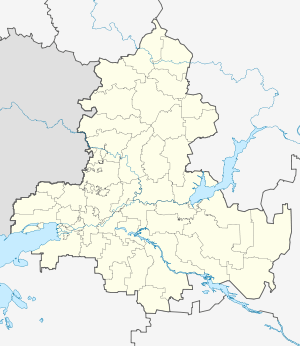 Taganrog | |
_(1808).png) |
 |
Coat of arms |
Flag |
| Anthem | Anthem of Taganrog[2] |
| City Day | September 12[3] |
| Administrative status (as of November 2014) | |
| Country | Russia |
| Federal subject | Rostov Oblast[1] |
| Administratively subordinated to | Taganrog Urban Okrug[1] |
| Administrative center of | Taganrog Urban Okrug[1] |
| Municipal status (as of October 2012) | |
| Urban okrug | Taganrog Urban Okrug[4] |
| Administrative center of | Taganrog Urban Okrug[4] |
| Head[5] | Andrey Lisitsky[6] |
| Representative body | City Duma[5] |
| Statistics | |
| Area | 80 km2 (31 sq mi)[7] |
| Population (2010 Census) | 257,681 inhabitants[8] |
| - Rank in 2010 | 72nd |
| Population (January 2016 est.) | 251,100 inhabitants[9] |
| Density | 3,221/km2 (8,340/sq mi)[10] |
| Time zone | MSK (UTC+03:00)[11] |
| Founded | September 12, 1698[3] |
| City status since | 1775[12] |
| Previous names | The Fortress Which Is on Tagan-Rog (officially, Troitskaya Fortress) (until 1775)[12] |
| Postal code(s)[13] | 347900, 347902, 347904, 347905, 347909, 347910, 347913, 347916, 347919, 347922–347924, 347927, 347928, 347930–347932, 347935, 347936, 347939, 347942, 347943, 347949, 347990 |
| Dialing code(s) | +7 8634 |
| Website |
www |
| Taganrog on Wikimedia Commons | |
| 2010 Census | 257,681[8] |
|---|---|
| 2002 Census | 281,947[14] |
| 1989 Census | 291,622[15] |
| 1979 Census | 276,444[16] |
Taganrog (Russian: Таганрог, IPA: [təɡɐnˈrok]) is a port city in Rostov Oblast, Russia, located on the north shore of the Taganrog Bay in the Sea of Azov, several kilometers west of the mouth of the Don River. As of the 2010 Census, its population was 257,681.[8]
History of Taganrog
The history of the city goes back to late Bronze Age–early Iron Age (between the 20th and 10th centuries BCE), when it was the earliest Greek settlement in the northwestern Black Sea Region, and was mentioned by the Greek historian Herodotus as Emporion Kremnoi.[17] Taganrog was officially founded by Peter the Great on September 12, 1698.[3] The first Russian Navy base, it hosted the Azov Flotilla of Catherine the Great (1770–1783), which subsequently became the Russian Black Sea Fleet. Taganrog was granted city status in 1775.[12]
By the end of the 18th century, Taganrog had lost its importance as a military base after Crimea and the entire Sea of Azov were absorbed into the Russian Empire. In 1802, Tsar Alexander I granted the city special status, which lasted until 1887. In 1825, the Alexander I Palace in Taganrog was used as the Tsar's summer residence, where he died in November 1825. Taganrog became important as a commercial port, used for the import and export of grain by the end of the 19th century until the early 20th century. Industrialization increased in the city when Belgian and German investors founded a boiler factory, an iron and steel foundry, a leather factory and an oil press factory. By 1911, fifteen foreign consulates had opened in the city.[18]
During World War I, Taganrog was occupied by the troops of the German Army from May 1918 until August. In 1919, General Anton Denikin established his headquarters at the Avgerino mansion in the city while commanding White Russian troops fighting in South Russia during the Russian Civil War. When the White Russians were defeated and Bolshevik power was established in the city on December 25, 1919, Denikin's remaining troops and the British Consulate were evacuated by HMS Montrose. Full power was granted to the Executive Committee of The City Soviet Workers' council on December 17, 1920, and Taganrog briefly joined the Ukrainian SSR as the administrative center of Taganrog Okrug, until it was transferred to the Russian SFSR along with Shakhty Okrug on October 1, 1924. During World War II, Taganrog was occupied by Nazi Germany from 1941 to 1943 during Operation Barbarossa, when two SS divisions entered the city on October 17, 1941, followed by Wehrmacht divisions, with the city suffering extensive damage. The occupation led to the local government system being replaced by German-style Bürgermeisteramt (Mayor's Office), which governed the city until it was liberated by the Red Army on August 30, 1943.
Administrative and municipal status
Within the framework of administrative divisions, it is incorporated as Taganrog Urban Okrug—an administrative unit with the status equal to that of the districts.[1] As a municipal division, this administrative unit also has urban okrug status.[4]
Climate
The climate of Taganrog is temperate (Köppen climate classification Dfa). Taganrog experiences moderately cold (mild by Russian standards) winters and hot summers.
| Climate data for Taganrog | |||||||||||||
|---|---|---|---|---|---|---|---|---|---|---|---|---|---|
| Month | Jan | Feb | Mar | Apr | May | Jun | Jul | Aug | Sep | Oct | Nov | Dec | Year |
| Average high °C (°F) | 0.1 (32.2) |
0.3 (32.5) |
5.9 (42.6) |
15.4 (59.7) |
22.1 (71.8) |
25.8 (78.4) |
28.8 (83.8) |
27.8 (82) |
21.8 (71.2) |
14.6 (58.3) |
5.5 (41.9) |
0.6 (33.1) |
14.1 (57.3) |
| Daily mean °C (°F) | −2.6 (27.3) |
−2.6 (27.3) |
2.7 (36.9) |
11.1 (52) |
17.6 (63.7) |
21.4 (70.5) |
24.6 (76.3) |
23.8 (74.8) |
18.1 (64.6) |
11.1 (52) |
2.8 (37) |
−2.1 (28.2) |
10.5 (50.9) |
| Average low °C (°F) | −5.5 (22.1) |
−5.8 (21.6) |
−0.7 (30.7) |
6.3 (43.3) |
12.4 (54.3) |
16.5 (61.7) |
19.7 (67.5) |
19.0 (66.2) |
13.8 (56.8) |
7.4 (45.3) |
0.3 (32.5) |
−4.8 (23.4) |
6.6 (43.8) |
| Average precipitation mm (inches) | 43 (1.69) |
40 (1.57) |
34 (1.34) |
38 (1.5) |
38 (1.5) |
58 (2.28) |
61 (2.4) |
39 (1.54) |
33 (1.3) |
34 (1.34) |
42 (1.65) |
50 (1.97) |
510 (20.08) |
| Source: Rostov-meteo.ru[19] | |||||||||||||
Economy
Taganrog is the leading industrial center of Rostov Oblast. Local industry is presented by aerospace, machine-building, automobile, military, iron and steel industry, engineering, metal traders and processors, timber, woodwork, pulp and paper, food, light, chemical and industry of construction materials, and one of the major ports of the Sea of Azov.
The biggest company currently operating in Taganrog is Taganrog Metallurgical Plant (publicly traded company Tagmet) which manufactures steel, steel pipe for oil and gas industry and consumer goods. The other major employer is Taganrog Auto Factory (TagAZ Ltd.) which originated from Taganrog Combine Harvester Factory. The plant manufactures automobiles licensed by Hyundai. The production line includes Hyundai Accent compact sedan, mid-size Hyundai Sonata, sport utility vehicle Santa Fe and Hyundai Porter pickup truck.
Taganrog is also home to the aircraft design bureau Beriev.
The area around Taganrog has a large industrial potential, a diversified agricultural industry, production plants and a modern infrastructure. The location of Taganrog on the intersection of traffic routes and the seaport facilitate access to the emerging CIS markets.
Taganrog's main trading partners are the CIS countries, South Korea, Turkey, Italy, Greece, and Egypt.
Military
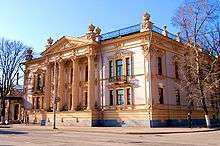
The Taganrog air base is located 3.6 miles (5.8 km) to the northwest of the city, and hosts the Taganrog Aviation Museum. The city also hosts a military museum.
Higher education
- Taganrog College of Technologies
- Taganrog State Pedagogical Institute
- Taganrog College of Management and Economy
Taganrog in literature
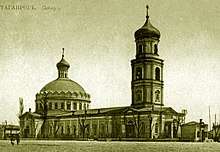
The image of the city and its people is featured in numerous Anton Chekhov works, including Ionych, The House with an Attic, The Man in a Shell, Van'ka, Three Years, Mask, My Life and more. It is believed that Taganrog image may be used as Lukomorye (fairy tale land) in Alexander Pushkin's Ruslan and Lyudmila (1820). It also appeared in the novels of Ivan Vasilenko, Konstantin Paustovsky and in the poems of Nikolay Sherbina and Valentin Parnakh.
The conspiratorial legend of "Elder Fyodor Kuzmich" is cited in the book Roza Mira by Russian mystic Daniil Andreyev. According to this legend, the Russian tsar Alexander I did not die in Taganrog, but instead left his crown and the status of monarch to continue his life as a traveling hermit.
In foreign literature, the city was mentioned in the titles of the following novels: Der Tote von Taganrog by Eberhard von Cranach-Sichart, Taganrog (dedicated to death or disappearance of Alexander I) by Reinhold Schneider.
In 2004 Irish poet of German heritage Sabine Wichert published a collection of poems titled Taganrog.
Notable people
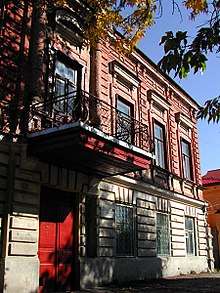
Numerous Russian and international aristocrats, politicians, artists, and scientists were born and/or have lived in Taganrog. Taganrog is the native city of Anton Chekhov, Faina Ranevskaya, Sophia Parnok, Alexandre Koyré, Isaac Yakovlevich Pavlovsky, and Dmitri Sinodi-Popov; names of Russian emperors Peter I of Russia and Alexander I of Russia; Cornelius Cruys, Giuseppe Garibaldi, Pyotr Tchaikovsky, Adolph Brodsky, Konstantin Paustovsky, Nestor Kukolnik, Achilles Alferaki, Ioannis Varvakis, Sergei Bondarchuk, William Frederick Yeames and many other famous people are brought to mind when Taganrog is mentioned.
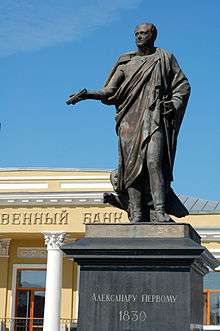
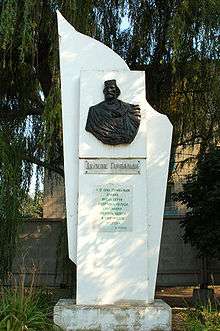

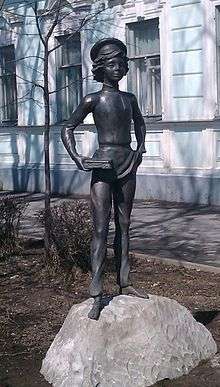 Monument "Artyomka"
Monument "Artyomka"
Twin towns and sister cities







See also
References
Notes
- 1 2 3 4 5 Law #340-ZS
- ↑ Decision #537
- 1 2 3 Charter of Taganrog, Article 2
- 1 2 3 Law #190-ZS
- 1 2 Charter of Taganrog, Article 12
- ↑ Official website of Taganrog. Andrey Vladimirovich Lisitsky, Head of the Administration of the City of Taganrog (in Russian)
- ↑ Official website of Taganrog. Information About Taganrog (in Russian)
- 1 2 3 Russian Federal State Statistics Service (2011). "Всероссийская перепись населения 2010 года. Том 1" [2010 All-Russian Population Census, vol. 1]. Всероссийская перепись населения 2010 года (2010 All-Russia Population Census) (in Russian). Federal State Statistics Service. Retrieved June 29, 2012.
- ↑ Rostov Oblast Territorial Branch of the Federal State Statistics Service. Cities with Populations of 100,000 and Over (in Russian)
- ↑ The value of density was calculated automatically by dividing the 2010 Census population by the area specified in the infobox. Please note that this value may not be accurate as the area specified in the infobox does not necessarily correspond to the area of the entity proper or is reported for the same year as the population.
- ↑ Правительство Российской Федерации. Федеральный закон №107-ФЗ от 3 июня 2011 г. «Об исчислении времени», в ред. Федерального закона №271-ФЗ от 03 июля 2016 г. «О внесении изменений в Федеральный закон "Об исчислении времени"». Вступил в силу по истечении шестидесяти дней после дня официального опубликования (6 августа 2011 г.). Опубликован: "Российская газета", №120, 6 июня 2011 г. (Government of the Russian Federation. Federal Law #107-FZ of June 31, 2011 On Calculating Time, as amended by the Federal Law #271-FZ of July 03, 2016 On Amending Federal Law "On Calculating Time". Effective as of after sixty days following the day of the official publication.).
- 1 2 3 Энциклопедия Города России. Moscow: Большая Российская Энциклопедия. 2003. pp. 454–455. ISBN 5-7107-7399-9.
- ↑ Почта России. Информационно-вычислительный центр ОАСУ РПО. (Russian Post). Поиск объектов почтовой связи (Postal Objects Search) (in Russian)
- ↑ Russian Federal State Statistics Service (May 21, 2004). "Численность населения России, субъектов Российской Федерации в составе федеральных округов, районов, городских поселений, сельских населённых пунктов – районных центров и сельских населённых пунктов с населением 3 тысячи и более человек" [Population of Russia, Its Federal Districts, Federal Subjects, Districts, Urban Localities, Rural Localities—Administrative Centers, and Rural Localities with Population of Over 3,000] (XLS). Всероссийская перепись населения 2002 года [All-Russia Population Census of 2002] (in Russian). Retrieved August 9, 2014.
- ↑ Demoscope Weekly (1989). "Всесоюзная перепись населения 1989 г. Численность наличного населения союзных и автономных республик, автономных областей и округов, краёв, областей, районов, городских поселений и сёл-райцентров" [All Union Population Census of 1989: Present Population of Union and Autonomous Republics, Autonomous Oblasts and Okrugs, Krais, Oblasts, Districts, Urban Settlements, and Villages Serving as District Administrative Centers]. Всесоюзная перепись населения 1989 года [All-Union Population Census of 1989] (in Russian). Институт демографии Национального исследовательского университета: Высшая школа экономики [Institute of Demography at the National Research University: Higher School of Economics]. Retrieved August 9, 2014.
- ↑ "Всесоюзная перепись населения 1979 г. Национальный состав населения по регионам России. (All Union Population Census of 1979. Ethnic composition of the population by regions of Russia.)". Всесоюзная перепись населения 1979 года (All-Union Population Census of 1979) (in Russian). Demoscope Weekly (website of the Institute of Demographics of the State University—Higher School of Economics. 1979. Retrieved 2008-11-25.
- ↑ "taganrogcity.com - Taganrog's Ancient History". taganrogcity.com.
- ↑ "taganrogcity.com - Taganrog History in the 19th Century". taganrogcity.com.
- ↑ "Rostov-meteo.ru". Retrieved April 17, 2012.
- ↑ "taganrogcity.com - Foreign Relations". taganrogcity.com.
- ↑ "The Home City of Chekhov and the Home City of Confucius Sign a Partnership Agreement". Taganrog Municipality. June 4, 2009. Retrieved August 6, 2009.
- ↑ "Taganrog signs Sister City agreement with Khartsyzsk, Ukraine". Taganrog Municipality. September 18, 2009. Retrieved October 29, 2009.
- ↑ "Sistercity relationship established with Antratsit City in Lugansk Oblast, Ukraine". Taganrog Municipality. December 7, 2012. Retrieved December 8, 2012.
Sources
- Городская Дума Таганрога. Решение №537 от 25 октября 2007 г. «Об официальных символах муниципального образования "Город Таганрог"», в ред. Решения №73 от 31 марта 2015 г «О внесении изменений в некоторые Решения Городской Думы города Таганрога». Вступил в силу со дня официального опубликования. Опубликован: "Официальный Таганрог", №35, 10 ноября 2007 г. (City Duma of Taganrog. Decision #537 of October 25, 2007 On the Official Symbols of the Municipal Formation of the "City of Taganrog", as amended by the Decision #73 of March 31, 2015 On Amending Various Decisions of the City Duma of the City of Taganrog. Effective as of the day of the official publication.).
- Городская Дума города Таганрога. Решение №318 от 3 июня 2011 г. «О принятии Устава муниципального образования "Город Таганрог"», в ред. Решения №243 от 29 сентября 2016 г «О внесении изменений и дополнений в Устав муниципального образования "Город Таганрог"». Вступил в силу со дня официального опубликования, произведённого после регистрации. Опубликован: "Официальный вестник Таганрога", №16, 25 июля 2011 г. (City Duma of the City of Taganrog. Decision #318 of June 3, 2011 On Adopting the Charter of the Municipal Formation of the "City of Taganrog", as amended by the Decision #243 of September 29, 2016 On Amending and Supplementing the Charter of the Municipal Formation of the "City of Taganrog". Effective as of the day of the official publication after the registration.).
- Законодательное Собрание Ростовской области. Закон №340-ЗС от 25 июля 2005 г. «Об административно-территориальном устройстве Ростовской области», в ред. Закона №270-ЗС от 27 ноября 2014 г. «О внесении изменений в областной Закон "Об административно-территориальном устройстве Ростовской области"». Вступил в силу со дня официального опубликования. Опубликован: "Наше время", №187–190, 28 июля 2005 г. (Legislative Assembly of Rostov Oblast. Law #340-ZS of July 28, 2005 On the Administrative-Territorial Structure of Rostov Oblast, as amended by the Law #270-ZS of November 27, 2014 On Amending the Oblast Law "On the Administrative-Territorial Structure of Rostov Oblast". Effective as of the official publication date.).
- Законодательное Собрание Ростовской области. Закон №190-ЗС от 19 ноября 2004 г. «Об установлении границы и наделении статусом городского округа муниципального образования "Город Таганрог"», в ред. Закона №980-ЗС от 25 октября 2012 г. «О внесении изменений в областные Законы "Об установлении границы и наделении статусом городского округа муниципального образования "Город Таганрог" и "Об установлении границ и наделении соответствующим статусом муниципального образования "Неклиновский район" и муниципальных образований в его составе"». Вступил в силу 1 января 2005 г. Опубликован: "Наше время", №293–295 (без приложений), 30 ноября 2004 г. (Legislative Assembly of Rostov Oblast. Law #190-ZS of November 19, 2004 On Establishing the Border and Granting Urban Okrug Status to the Municipal Formation of the "City of Taganrog", as amended by the Law #980-ZS of October 25, 2012 On Amending the Oblast Laws "On Establishing the Border and Granting Urban Okrug Status to the Municipal Formation of the "City of Taganrog" and "On Establishing the Borders and Granting an Appropriate Status to the Municipal Formation of "Neklinovsky District" and to the Municipal Formations It Comprises". Effective as of January 1, 2005.).
External links
- Taganrogcity.com: official City of Taganrog website—(in English)
- Tagancity.ru: official website of Taganrog city—(in Russian)
- Taganrog.su: unofficial website of Taganrog—(in Russian)
- Taganrog State − Anton Chekhov Pedagogical Institute—(in Russian)
- Soviet topographic map 1:100,000
- Russ-yug.ru: Weather forecasts for Taganrog
| Wikimedia Commons has media related to Taganrog. |

